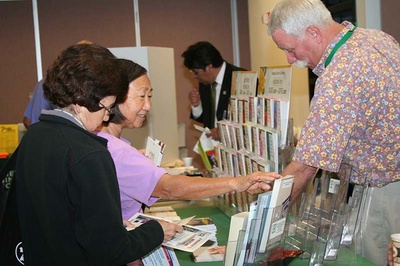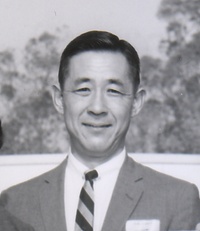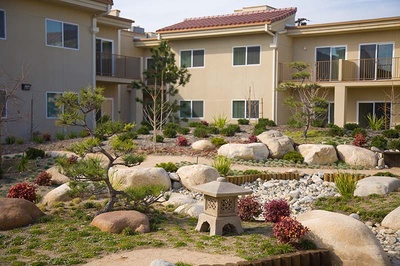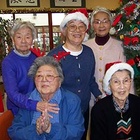My mother is in some ways a typical Southern California Nisei. She has participated in organized Nikkei ballroom dance, camera club, and widow’s groups. She plays marathon card games regularly with a group of Nisei friends, and travels the world on organized Japanese-American tours. A lot of her time also seems to be taken up arranging club dinners or luncheons, or the entertainment and door prizes that are an expected feature of these events.
Although my mother is healthy and sharp-minded, she is at the age where she and many of her friends are thinking about the prospect of moving to a retirement home or an assisted living facility. Most of her friends have children who are busy working and raising their own families, and some of them, like me, live far away. No one assumes that the tradition of oya kōkō (filial piety) is strong enough among Sansei to guarantee in-home care by a child or daughter-in-law, something that was once the norm for Japanese families.
Keiro Retirement Home in Boyle Heights would seem to be the natural solution. It’s not far from the Eastside home my mother has lived in for the past 50 years, and she knows it well. Her own mother, my grandmother, lived there for over six years before she died at age 105, and my mother at one time provided speech therapy for Issei stroke patients living at Keiro Nursing Home.
Yet moving into Keiro is not a foregone conclusion for her. “For one thing, there’s a very long waiting list for the Keiro Retirement Home,” my mother tells me. (The waiting list is anywhere from two to six years, according to Shawn Miyake, president and CEO of Keiro Senior HealthCare.) “Then,” my mother adds, if you get a studio and you want a one bedroom, there’s a long waiting list for that, too. Plus, there are a lot of Shin-Issei (new or recently immigrated Issei) going in there, too. So people are looking at a lot of other places now.”
Some of my mother’s friends are looking at non-Japanese retirement home options. The high comfort level that comes with being among other Japanese “is kind of nice,” she says, but adds, “if you balance everything out, that’s just a small part of it.” One acquaintance, in fact, opted for Keiro and “is really tired of the food now.” She wouldn’t tire of Japanese food—she likes the fact that Keiro serves saba (mackerel) dinners once in a while, and offers Japanese activities such as karuta (a Japanese card game). Ultimately, however, my mother says she doesn’t consider a Japanese environment a must-have in a retirement home.
At the moment, Keiro Senior HealthCare has no trouble filling its four facilities: a nursing home, intermediate care facility and retirement home in L.A., and a nursing home in Gardena. In addition to its reputation for providing high-quality, low-cost and culturally sensitive care, “a clear reason why we’re sustainable,” says Miyake, is the large L.A.-area Shin-Issei population of about 50,000 people. Add to that number the 180,000 Japanese Americans in the Orange, L.A. and Ventura County region, and Miyake projects that Keiro will be “going strong for the next twenty to thirty years.”
Though Keiro’s immediate future looks secure, my mother’s dilemma reflects a reality that Nikkei eldercare organizations throughout the West Coast will all have to face sooner or later: decreased demand for a Japanese cultural environment as Nikkei increasingly assimilate into mainstream culture. The aging Nisei generation is already considering—some even actively seeking—non-Japanese eldercare facilities. What will happen to these organizations when the Sansei and Yonsei, whose self-identification as Japanese is even more diluted, are ready to retire?
There are other obstacles to the future welfare of Nikkei eldercare organizations as well. One is geographic: the old Japantowns of Los Angeles, San Francisco, Seattle and San Jose have gradually lost their strong Japanese identity as new immigrant communities have arrived. Second-, third- and fourth-generation JAs have moved away from these urban centers, and many will not want to return for their retirement years.
Then there are the financial pressures caused by the rising cost of healthcare, unpredictable federal and state reimbursements and shrinking federal, state and local grant money. Like all eldercare organizations, Nikkei facilities will also have to figure out which of the many emerging models of eldercare will suit their communities best.
To see how eldercare organizations up and down the West Coast are coping with these thorny issues, I spoke to representatives from six Nikkei or Asian American eldercare organizations. The combination of recession and rising health care costs has strained their budgets and increased pressure to step up fundraising; most of them work with annual budget shortfalls. Yet these facilities are also searching for creative, forward thinking solutions to their problems, including new models of care to reflect the shifting needs of their communities. This was especially true for increasingly multi-ethnic centers outside of L.A., where smaller JA and Shin-Issei populations make the need to change and adapt more urgent.
Keiro Senior HealthCare in Los Angeles, was founded in 1961 [*see article “Profile: James Mitsumori, one of Keiro Senior HealthCare’s Founding Fathers” for more on the history of Keiro] by a group of Nisei who recognized the need for a Japanese nursing home for elderly Issei who did not speak English and would not be comfortable in English-speaking homes. Keiro L.A. (as some people call it to avoid confusion with Seattle Keiro) is the largest Japanese eldercare facility in the U.S. and its four facilities are usually very near its 642-resident capacity, says Miyake.
Half of new admissions to the retirement home are Shin-Issei. “It’s really odd,” says Miyake, “we’ve come back to our original mission in a cultural sense, and yet it’s a different type of resident.” Although he would have guessed that Shin-Isseiapartments would reflect more of a Japanese cultural sensibility than JA quarters, Miyake says that in fact the opposite is true: the Shin-Issei apartments tend to be more contemporary in décor, and less Japanese.
Miyake does think about the Sansei and Yonsei generations, and the question of whether they will choose Keiro when it is their time to seek care outside their homes. In the 2000 U.S. Census, 53% of 5- to 17-year olds in the Los Angeles area were identified as multi-racial, Miyake notes. That figure jumped to 72% in 2008. Project forward 50 or 60 years, and it’s clear that future L.A.-area Nikkei, “with so much DNA diffusion,” as Miyake puts it, will feel less need to retire to Keiro’s comfortable cultural cocoon.
Keiro has conducted a series of focus groups to find out what its future clients are thinking. For “the fifties, sixties and seventies generation,” says Miyake, “there is still a strong affinity for places like this, although it’s slowly dissipating.” One study conducted in Seattle showed that Nikkei who came of age in those decades want to live in a community with some Japanese, says Miyake, but with more diversity.”
The problem during the next 20 or 30 years, Miyake believes, “is less about the mixed-race, happa kind of thing, and more about location: as we’ve geographically dispersed, do people want to come back to live in the Hispanic community” that predominates in Boyle Heights now?”
Judged on cost alone, Keiro is highly attractive. The average rate at Keiro Nursing Home for a semi-private room is $175 per day, or $195 per day for a private room, significantly below the $192 and $240 market rates for nursing homes in the Los Angeles area, according to the 2009 MetLife market survey of nursing home costs. Keiro does not charge hefty entry or maintenance fees, as some nursing homes do. It does follow a plan of “a la carte” pricing to allow more choice and keep costs low for residents, Miyake explains. For example, medication management assistance costs $200 per month, and laundry service will run an extra $80 per month.
Although the issue of shrinking Medicare and Medicaid reimbursements (Medicare covers basic health care for U.S. citizens over 65, while Medicaid—known as Medi-Cal in California—covers nursing home care) has been an important part of the current healthcare reform debate, Miyake says he is actually pleased with the current state of government reimbursements, which account for about 60 to 70 percent of Keiro’s $32 million annual budget. “They are fairer now than they have ever been,” he notes, thanks in part to a “bed tax” that states levy on Medi-Cal funds to enable increased payments to nursing facilities. One problem, however, Miyake says, is receiving government payments on time. Keiro is “hostage to the budgeting process,” which means it has to build up a bigger reserve to cover late payments.
Despite Keiro’s rosy occupancy numbers and the high demand for its services, the non-profit runs a $2 million annual budget shortfall. Medi-Cal can often pay less than total patient care costs, up to $10,000 less per Medi-Cal patient a year. So far, says Miyake, fundraising efforts and strong financial support among the JA community have allowed Keiro to make up most of the difference. All of the eldercare facilities I spoke with for this article, in fact, rely on powerful and indispensable volunteer forces, which supply not only the manpower to run classes, support groups, activities and trips, but constitute the compassionate heart of the Japanese American old folks home. Miyake believes that this level of support is unique to the Nikkei community. “It’s something we should really relish and celebrate,” he says.
This strong sense of Keiro as a community endeavor accounts for one feature that all Nikkei facilities seem to share: a reluctance to sacrifice quality of care in the face of budget shortfalls. Skip McDonald, Ph.D., chief operating officer/administrator at Nikkei Concerns, the umbrella organization that includes Seattle Keiro, says, board members there are less concerned about making money, “which historically we’ve not done, so much as making sure we meet a high level of service expectation.” Miyake explains the phenomenon this way: “It goes back to our mothers. When I first came to work [at Keiro], my mother told me, ‘Don’t do anything to embarrass me.’ If you’re taking care of friends, relatives, or acquaintances, it’s important to have the highest level of quality. It’s more about making sure I don’t embarrass my community.”
One question that only time will answer is whether this kind of traditional Japanese commitment to community will last, or if donations will taper off as the Sansei and Yonsei generations’ attention and pocketbooks are pulled in different directions. Miyake recalls his parents, like mine, who spent all their spare time volunteering to serve as officers or leaders of their Nikkei organizations. “Everyone got their chance at leadership, whether they were good or bad at it, it was a duty. I don’t think we have that same sense of duty today. If a church goes out of business, people will say, ‘I’ll just go to the nearest one.’ For my parents it would have been the end of their world to lose the community center, or the Buddhist church,” says Miyake.
Another challenge is that grants to Keiro have slowed to a trickle. Takashi Makinodan, Ph.D., a retired UCLA professor of medicine and a Keiro board member, says getting federal, state and local grants is much harder now because “the Japanese are looked upon as a rich community. We have to spend many months to write a highly competitive grant because of that bias.”
Keiro was at one time the only Nikkei eldercare choice in town. Recently though, competition has begun to appear in the form of upscale, retirement and assisted living homes that cater to Japanese or more mixed-race clientele. “There really are a lot of nice places cropping up all over the place,” my mother tells me. “Some are completely refurbished and up to date. We saw one with a nice dining room where they wait on you. A lot of places have the three levels, retirement home, intermediate care and the nursing home, all on one campus. If you need to change levels of care, you don’t need to change apartments, you just pay more and they will provide all the services.” She admits, though, that “there aren’t that many Japanese there.”

Keiro has launched The Institute for Healthy Aging at Keiro to promote healthy lifestyles in our community. (Photo courtesy of Keiro Senior HealthCare)
One assisted living retirement home, Nikkei Senior Gardens opened up in Arleta in the San Fernando Valley in March 2009 and especially impressed my mother. A dear friend of hers spent her last days there in a spacious apartment with a living room and kitchenette. “If you live in the Valley, it’s perfect,” my mother says with a twinge of envy.
Although Nikkei Senior Gardens is unrelated to Keiro Senior HealthCare, Miyake says Keiro has offered the newer home technical assistance, and refers clients there. He considers the facility “part of the network.” While Keiro will not try to keep up with this type of more upscale facility, it is planning future expansion, likely to the south of Los Angeles, where focus groups have indicated the biggest demand lies. One plan, for a HUD (the U.S. Department of Housing and Urban Development)-funded assisted living facility in Gardena fell through, and is now on hold.
In the meantime, says Miyake, “Keiro will continue to grow. It’s just going to look different. We have to adjust to the times in order to stay relevant.”
Next: Nikkei Eldercare in San Francisco and San Jose
*Note: Some corrections were made to the information within this article on 3/31/10 at the request of Keiro and the author. Permission for Keiro’s photos was granted to appear on Discover Nikkei only.
© 2010 Nancy Matsumoto









